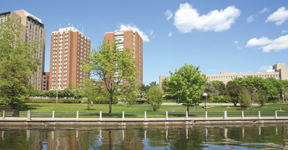Trevor Tucker

It’s a reality right under our feet, above our heads, in the walls of our classrooms and offices, but few of us know it. From the green roofs of the Colonel By Building and the University Centre to its aggressive transportation policies, to its lauded energy efficiencies … the University of Ottawa is green.
“Being so compact means that we build up instead of out, explains sustainability coordinator Jonathan Rausseo. “And that keeps us more energy efficient.” On our compact campus, with each building linked to the next, excess heat from one is moved to the next, as is the heat from computer servers and cold water from our aquatic care centre. Our carbon footprint per student is one of the lowest in the country, half of some of the larger universities.
Ironically, sustainable building practice also involves not building at all. “It is firstly what you don’t build that counts, explains Chief Architect Claudio Brun Del Re. “We have completely refocused our activities onto planning and programming to reduce the amount of space that we’re building.” He adds, “This involves much less space than it would have 20 years ago.”
The policy does not ignore aesthetics, however, as evidenced in the plans for the Social Sciences Tower. Next spring, before shovel is put to ground, 120 University Street will be “deconstructed” and the materials recycled. The new fifteen-story tower will have a green roof, an outer skin and windows of the highest acoustic and thermal standards, loads of “daylight harvesting,” more visible staircases and, in accordance with university policy, no carpets.
Still not green enough? A five-story “living wall” will both enhance the feel of the interior and serve as an air bio-filter. “These walls have an amazing effect on the space…its like staring into a jungle,” explains Brun Del Re. “It’s vertical hydroponics.”
Sustainability is clearly more than just techno advances and high-grade materials; it’s also about how we feel in a space, and how our public areas bridge the natural with the built environment. By the end of this project (2014) the parking lot now encircled by Vanier, Morrisset, and Lamoureux will be a piazza. Brun Del Re foresees a place with awnings, grade-level food vendors—a space that could even host 6-7000 spectators for outdoor concerts. uOttawa’s town square.
Since the early 70’s when uOttawa began stringent cuts to energy use, we have had an award-winning green record. “Though it has never been coined that way, we have always done sustainable architecture,” says Brun Del Re. “Today there are many shades of green.”